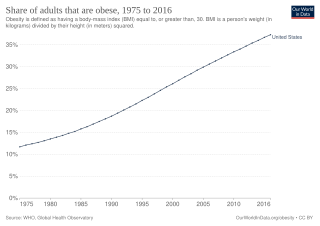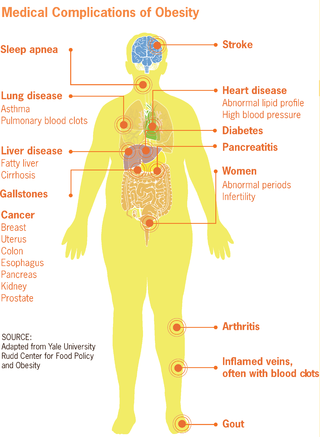Related Research Articles

Body mass index (BMI) is a value derived from the mass (weight) and height of a person. The BMI is defined as the body mass divided by the square of the body height, and is expressed in units of kg/m2, resulting from mass in kilograms (kg) and height in metres (m).

Obesity is a medical condition, sometimes considered a disease, in which excess body fat has accumulated to such an extent that it can potentially have negative effects on health. People are classified as obese when their body mass index (BMI)—a person's weight divided by the square of the person's height—is over 30 kg/m2; the range 25–30 kg/m2 is defined as overweight. Some East Asian countries use lower values to calculate obesity. Obesity is a major cause of disability and is correlated with various diseases and conditions, particularly cardiovascular diseases, type 2 diabetes, obstructive sleep apnea, certain types of cancer, and osteoarthritis.

An underweight person is a person whose body weight is considered too low to be healthy. A person who is underweight is malnourished.

The waist–hip ratio or waist-to-hip ratio (WHR) is the dimensionless ratio of the circumference of the waist to that of the hips. This is calculated as waist measurement divided by hip measurement. For example, a person with a 75 cm waist and 95 cm hips has WHR of about 0.79.
The body fat percentage of an organism is the total mass of its fat divided by its total body mass, multiplied by 100; body fat includes essential body fat and storage body fat. Essential body fat is necessary to maintain life and reproductive functions. The percentage of essential body fat for women is greater than that for men, due to the demands of childbearing and other hormonal functions. Storage body fat consists of fat accumulation in adipose tissue, part of which protects internal organs in the chest and abdomen. A number of methods are available for determining body fat percentage, such as measurement with calipers or through the use of bioelectrical impedance analysis.

Health in Switzerland relates to a variety of issues. Namely, water and sanitation, diet and fitness, various addictions, mental fitness, communicable diseases, hygiene and the environment.

Obesity is common in the United States and is a major health issue associated with numerous diseases, specifically an increased risk of certain types of cancer, coronary artery disease, type 2 diabetes, stroke, and cardiovascular disease, as well as significant increases in early mortality and economic costs.

Being overweight is having more body fat than is optimally healthy. Being overweight is especially common where food supplies are plentiful and lifestyles are sedentary.

Preventable causes of death are causes of death related to risk factors which could have been avoided. The World Health Organization has traditionally classified death according to the primary type of disease or injury. However, causes of death may also be classified in terms of preventable risk factors—such as smoking, unhealthy diet, sexual behavior, and reckless driving—which contribute to a number of different diseases. Such risk factors are usually not recorded directly on death certificates, although they are acknowledged in medical reports.

Obesity is a risk factor for many chronic physical and mental illnesses.

Obesity has been observed throughout human history. Many early depictions of the human form in art and sculpture appear obese. However, it was not until the 20th century that obesity became common — so much so that, in 1997, the World Health Organization (WHO) formally recognized obesity as a global epidemic and estimated that the worldwide prevalence of obesity has nearly tripled since 1975. Obesity is defined as having a body mass index (BMI) greater than or equal to 30 kg/m2, and in June 2013 the American Medical Association classified it as a disease.

While genetic influences are important to understanding obesity, they cannot explain the current dramatic increase seen within specific countries or globally. It is accepted that calorie consumption in excess of calorie expenditure leads to obesity; however, what has caused shifts in these two factors on a global scale is much debated.

Obesity in the United Kingdom is a significant contemporary health concern, with authorities stating that it is one of the leading preventable causes of death. In February 2016, former Health Secretary Jeremy Hunt described rising rates of childhood obesity as a "national emergency". The National Childhood Measurement Programme, which measures obesity prevalence among school-age pupils in reception class and year 6, found obesity levels rocketed in both years groups by more than 4 percentage points between 2019–20 and 2020–21, the highest rise since the programme began. Among reception-aged children, those aged four and five, the rates of obesity rose from 9.9% in 2019–20 to 14.4% in 2020–21. By the time they are aged 10 or 11, more than a quarter are obese. In just 12 months, the rate is up from 21% in 2019–20 to 25.5% in 2020–21.

Obesity classification is a ranking of obesity, the medical condition in which excess body fat has accumulated to the extent that it has an adverse effect on health. The World Health Organization (WHO) classifies obesity by body mass index (BMI). BMI is further evaluated in terms of fat distribution via the waist–hip ratio and total cardiovascular risk factors. In children, a healthy weight varies with sex and age, and obesity determination is in relation to a historical normal group.

Obesity in Germany has been increasingly cited as a major health issue in recent years. The federal government has declared this to be a major issue.
Obesity in Austria has been increasingly cited as a major health issue in recent years. Forty per cent of Austrians between 18 and 65 are considered overweight while eleven per cent of those overweight meet the definition of obesity. Forbes.com ranks Austria as the 52nd fattest country in the World with a rate of 57.1%. Approximately 900,000 people are considered obese.
Obesity in France is a growing health issue. Obesity in children is growing at a faster rate than obesity in adults.
Paul Deurenberg is a Dutch retired academic, nutritional biochemist and consultant. He was a former associate professor in the Department of Human Nutrition at Wageningen University (WU), and is most known for his research expertise in the areas of energy metabolism, food consumption, and body composition studies.
References
- 1 2 "Body Mass Index (BMI)". Bundesamt für Statistik. 2019-02-28. Retrieved 2021-06-23.
- ↑ "Swiss women score best BMI figures in Europe". Swissinfo. April 1, 2016. Retrieved July 14, 2019.
- ↑ "Der Westen wird immer dicker" (in German). Süddeutsche Zeitung. August 23, 2010. Retrieved March 8, 2011.
- ↑ "Der Westen wird immer dicker" (in German). Neue Zürcher Zeitung. February 1, 2010. Retrieved March 8, 2011.